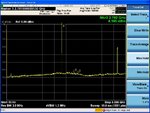Mabrok
Full Member level 4
Hi,
During my measurements for an RF power amplifier. Once I biased the device, I see overloaded on VNA screen. What can make this overloaded?
Note: My device consider as high power amplifier (Pout= 40 dBm), and I have used an attenuator of 20 dB between the output of the amplifier and port 2 of VNA.
During my measurements for an RF power amplifier. Once I biased the device, I see overloaded on VNA screen. What can make this overloaded?
Note: My device consider as high power amplifier (Pout= 40 dBm), and I have used an attenuator of 20 dB between the output of the amplifier and port 2 of VNA.

